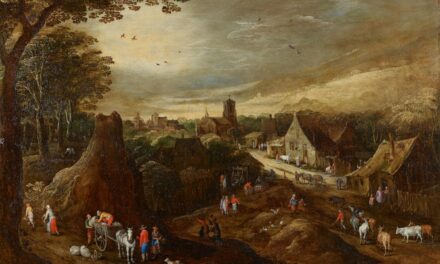Paolo Uccello, born in 1397 in Florence, is often celebrated as one of the early masters of the Italian Renaissance. His formative years were steeped in the rich cultural milieu of Florence, a city that was a crucible for artistic innovation and intellectual exploration. Uccello’s early life remains somewhat shrouded in mystery, but it is widely believed that he was initially trained as a painter under the tutelage of the renowned artist, Lorenzo Ghiberti.
Ghiberti, famed for his bronze doors of the Florence Baptistery, instilled in Uccello a profound appreciation for perspective and composition, elements that would later define his own artistic journey. As a young artist, Uccello was also influenced by the burgeoning interest in naturalism and the study of geometry that characterised the early Renaissance. His exposure to the works of contemporaries such as Masaccio and Donatello further enriched his understanding of form and space.
Uccello’s training was not limited to painting; he was also fascinated by the mathematical principles underlying art. This fascination would later manifest in his innovative use of perspective, which became a hallmark of his style. By the time he began to establish himself as an independent artist, Uccello had already developed a unique approach that combined rigorous geometric principles with a vivid imagination.
Summary
- Paolo Uccello was born in Florence, Italy, in 1397 and received his early training as a painter and mosaicist.
- Uccello was heavily influenced by the works of Giotto and Donatello, and his style was characterised by his use of perspective and geometric forms.
- His notable works include “The Battle of San Romano” and commissions for the Duomo in Florence and the Basilica of San Marco in Venice.
- Uccello was known for his innovative use of perspective and experimentation with foreshortening and depth in his paintings.
- Uccello’s legacy and impact on the art world can be seen in his influence on future generations of artists, particularly in the realm of perspective and composition.
Influences and Style
Influence of Humanist Ideals
However, it was the burgeoning humanist ideals of the Renaissance that truly shaped his artistic vision. Uccello’s commitment to depicting the human figure with accuracy and emotion marked a significant departure from the more stylised representations of earlier periods. One cannot discuss Uccello’s style without mentioning his pioneering use of perspective.
Pioneering Use of Perspective
He was one of the first artists to fully embrace the mathematical principles of perspective, creating a sense of depth and realism that was revolutionary for his time. This technique is particularly evident in works such as “The Battle of San Romano,” where the spatial arrangement of figures and objects draws the viewer into the scene.
Exploration of Themes
Uccello’s fascination with perspective extended beyond mere representation; it became a means for him to explore themes of conflict and movement, imbuing his compositions with a dynamic energy that captivates audiences even today.
Notable Works and Commissions
Among Uccello’s most celebrated works are his three panels depicting “The Battle of San Romano,” commissioned by the Medici family. These panels, painted between 1435 and 1460, are not only remarkable for their artistic execution but also for their historical significance. Each panel captures a different moment from the battle, showcasing Uccello’s mastery of perspective and his ability to convey motion and drama.
The vivid colours and intricate details invite viewers to immerse themselves in the chaos of battle, while the careful arrangement of figures demonstrates Uccello’s deep understanding of spatial relationships. In addition to “The Battle of San Romano,” Uccello created several other notable works that reflect his unique style and innovative techniques. His painting “The Virgin and Child with Saints” exemplifies his ability to blend religious themes with a keen sense of realism.
The figures are rendered with a delicate touch, their expressions conveying a sense of serenity and grace. This work, along with others such as “St. George and the Dragon,” showcases Uccello’s versatility as an artist and his capacity to engage with both secular and sacred subjects.
Techniques and Innovations
Uccello’s contributions to art extend beyond his stylistic choices; he was also an innovator in terms of technique. His exploration of linear perspective was groundbreaking, allowing him to create compositions that felt both expansive and intimate. By employing a vanishing point and carefully calculating the angles of objects within his scenes, Uccello was able to achieve a level of depth that had not been seen before.
This technique not only enhanced the realism of his work but also influenced generations of artists who followed in his footsteps. Moreover, Uccello’s use of colour is noteworthy. He employed a vibrant palette that brought his subjects to life, using colour not merely for decoration but as a means to convey emotion and atmosphere.
His ability to juxtapose contrasting hues created a sense of dynamism within his compositions, drawing viewers’ eyes across the canvas. This innovative approach to colour theory would later be echoed by artists such as Titian and Raphael, further solidifying Uccello’s place in art history as a pioneer of colour usage.
Uccello’s Legacy and Impact
The legacy of Paolo Uccello is profound, extending far beyond his own lifetime. His pioneering work in perspective laid the groundwork for future generations of artists who sought to explore spatial relationships within their compositions. The principles he developed were instrumental in shaping the trajectory of Western art, influencing not only painters but also architects and sculptors who embraced similar techniques in their own work.
Uccello’s impact can be seen in the works of later Renaissance masters such as Leonardo da Vinci and Michelangelo, who built upon his innovations while adding their own unique interpretations. Furthermore, Uccello’s exploration of narrative within his paintings has left an indelible mark on the art world. His ability to convey complex stories through visual means has inspired countless artists to consider how narrative can be woven into their own work.
The dramatic tension present in pieces like “The Battle of San Romano” continues to resonate with contemporary audiences, demonstrating that Uccello’s insights into storytelling through art remain relevant even today.
Personal Life and Relationships
While much about Uccello’s personal life remains elusive, it is known that he married a woman named Gentile di Niccolò in 1436, with whom he had several children. His family life appears to have been relatively stable, although records from this period are sparse. It is suggested that Uccello’s marriage may have influenced his artistic output; some scholars argue that the domestic sphere provided him with both inspiration and support as he navigated the challenges of being an artist during a time when patronage was essential for success.
Uccello’s relationships with other artists also played a significant role in shaping his career. He was part of a vibrant artistic community in Florence, where collaboration and competition coexisted harmoniously. His interactions with contemporaries such as Donatello and Masaccio likely spurred him on to refine his techniques and explore new ideas.
These relationships fostered an environment where innovation thrived, allowing Uccello to develop his distinctive style while remaining engaged with the broader artistic discourse of his time.
Reception and Criticism
During his lifetime, Uccello received both acclaim and criticism for his work. While many recognised his innovative approach to perspective and composition, others were less enthusiastic about his stylistic choices. Some critics argued that his emphasis on geometric precision detracted from the emotional depth often found in more traditional forms of painting.
This tension between technical mastery and emotional resonance would continue to be a point of contention among art critics long after Uccello’s death. In subsequent centuries, however, Uccello’s reputation has undergone a significant transformation. Art historians have come to appreciate his contributions to the development of perspective and narrative within painting, recognising him as a pivotal figure in the transition from Gothic to Renaissance art.
Today, he is celebrated not only for his technical innovations but also for his ability to convey complex themes through visual storytelling. This shift in perception underscores the evolving nature of art criticism and highlights how artists like Uccello can be re-evaluated through different historical lenses.
Exhibitions and Recognition
Uccello’s works have been featured in numerous exhibitions around the world, showcasing his enduring influence on art history. Major galleries such as the National Gallery in London and the Louvre in Paris have hosted exhibitions dedicated to Renaissance art, often highlighting Uccello’s contributions alongside those of other masters from this transformative period. These exhibitions serve not only to celebrate Uccello’s artistry but also to contextualise his work within the broader narrative of Renaissance innovation.
In addition to exhibitions, Uccello has been recognised through various scholarly publications that delve into his life and oeuvre. Art historians continue to study his techniques and thematic explorations, contributing to an ever-growing body of literature that seeks to understand his place within the pantheon of great artists. As new discoveries emerge regarding his life and work, Uccello’s legacy remains vibrant, ensuring that future generations will continue to engage with his remarkable contributions to the world of art.
If you are interested in exploring different artistic techniques, you may also enjoy reading about watercolor composition tips. This article provides valuable insights on how to balance flow and focal points in your artwork, which can be particularly helpful when studying the intricate details of artists like Paolo Uccello. By understanding the principles of composition, you can enhance your own artistic skills and appreciation for the work of masters like Uccello.
FAQs
Who was Paolo Uccello?
Paolo Uccello was an Italian painter and mathematician who was active during the Early Renaissance period. He was known for his innovative use of perspective and his contributions to the development of visual art.
What was Paolo Uccello known for?
Paolo Uccello was known for his mastery of perspective and his use of geometric principles in his paintings. He was also known for his meticulous attention to detail and his innovative approach to composition.
What are some of Paolo Uccello’s most famous works?
Some of Paolo Uccello’s most famous works include “The Battle of San Romano,” a series of three paintings depicting a battle scene, and “The Hunt in the Forest,” a landscape painting that showcases his use of perspective and depth.
How did Paolo Uccello contribute to the development of visual art?
Paolo Uccello’s innovative use of perspective and his mathematical approach to composition had a significant impact on the development of visual art during the Renaissance. His work influenced future generations of artists and helped to shape the way in which space and depth were depicted in paintings.
What was Paolo Uccello’s artistic style?
Paolo Uccello’s artistic style was characterized by his use of perspective, geometric principles, and attention to detail. He often depicted scenes with a sense of depth and space, and his compositions were carefully constructed using mathematical principles.
What is the significance of Paolo Uccello’s work in the history of art?
Paolo Uccello’s work is significant in the history of art because of his pioneering use of perspective and his mathematical approach to composition. His innovative techniques had a lasting impact on the development of visual art and continue to be studied and admired by art historians and scholars.


